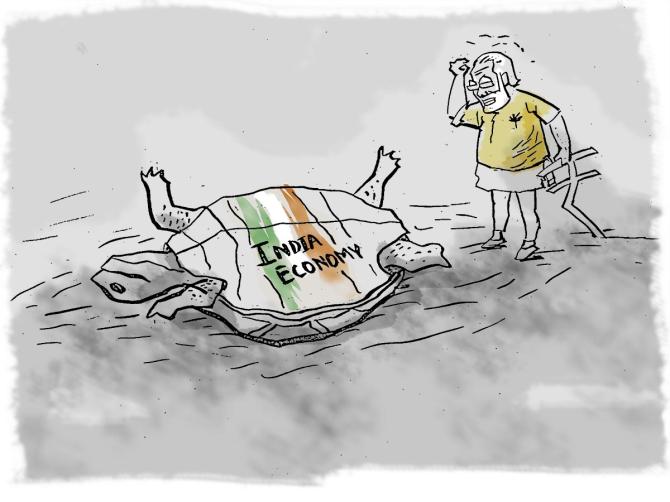 | « Back to article | Print this article |
'The outlook for private investment, which has been such a weak link for India for so long, remains challenging.'
Illustration: Dominic Xavier/Rediff.com

Oxford Economics, the global economic forecasting firm, recently released a report on the Indian economy, A Reopening Gone Wrong.
Contrary to the government's claims that green shoots have started appearing, the Oxford Economics report paints a grim picture.
According to the report, India fares the worst on the Asia recovery scorecard, and would take the longest among the major Asian economies to converge to its pre-coronavirus growth level.
It further says that GDP growth may lose momentum from late Q3 (July to September 2020), once the push from the initial reopening fades.
"You cannot forget the stringency of the lockdown. India went into a deeper hole because of that, and naturally it will take that much longer to climb up," Priyanka Kishore, the head of India and South East Asia Economics at Oxford Economics and the economist behind the study, tells Shobha Warrier/Rediff.com. The first of a two-part interview:
You titled your study, A Reopening Gone Wrong. India went into lockdown in late March, but today India's covid cases are the third highest in the world. So, is it the lockdown that went wrong, or the reopening that is going wrong?
Yes, India went into lockdown early, and at that time, there was very little information available globally. So, to be cautious was right.
But what aggravated the situation was, it was a very harsh lockdown. When you look at countries like Italy which were locking down at that time, India's lockdown was much more stringent.
That was probably not needed given that the government did not have much fiscal arsenal to ease the economic misery caused by the lockdown.
So, what happened between March 25 till April 20 was very stringent.
Then you entered a second phase of the lockdown.
During the second and third phase of lockdown, the amount of restrictions were more reasonable.
When cases were rising, you needed some amount of social distancing measures in place. But when you eased the restrictions and moved to the second and third phase, you should have stayed there longer.
However, the economy still needed a lot of fiscal support, which the government was unable to deliver and instead, chose to accelerate the reopening. At least at the Centre level.
Though the Centre has reopened the economy on paper, most of the states are still under strict lockdown.
Yes, you are right. When India went into lockdown, it was much more coordinated.
But when the reopening started, it was chaotic.
Now when the Centre has come out with Unlock 3, many of the states have not even reached Unlock 2. In fact, some of the states are choosing to re-impose tighter lockdowns in major cities.
Do you feel because of the high social disparity, the humanitarian crisis in the form of the mass exodus of labourers after the first lockdown, affected the economy much more than the health crisis?
Going by the available data, one could say that. Because India was, and is, not testing enough, it is difficult to get a sense of the true extent of the health crisis.
Health numbers are likely being under reported; both the number of infected cases, and probably the death count too.
So, if you take just the reported numbers, the humanitarian crisis that the lockdown caused because of the lack of fiscal backup, was stronger than the health crisis, to begin with.

The health crisis started hitting a bit later. At that time, they were so overwhelmed by the migrant workers situation, that they decided to open up everything.
Experts say the government's stimulus package of Rs 20 lakh crore has not stimulated the economy at all. Do you also feel that way?
The government did right in the first instance when they gave a bit of cash and grains to the most vulnerable. They realised that there was a lot of social disparity in India, and these are the people who needed immediate help.
That said, even that was not enough to start with.
But the follow-up has been pretty disappointing because the government primarily focused on giving cheaper credit to businesses.
The vulnerable sections of society and smaller businesses were not supported adequately.
The survival package was meagre, and a revival package was not even mentioned in a coherent fashion. It was disappointing.
In fact, the actual spending figure was way lower than the headline figure.
Your study says India fared the worst among the other major Asian economies in your Asian recovery scoreboard.
 Yes, we looked at 27 indicators and broke them into different buckets.
Yes, we looked at 27 indicators and broke them into different buckets.
One was the vulnerability indicator which meant how India was inherently capable of handling a crisis like this, in terms of both health and economic parameters.
Next was, as the crisis went on, how much success the country had in dealing with the virus which, of course, was not very good for India.
Then, what kind of policies you came up with. Yes, on the monetary side, India fared better than most countries, but on the fiscal side, not at all.
I have argued that fiscal should have been the lead tool in this crisis.
Also, you cannot forget the stringency of the lockdown. Actually, India went into a deeper hole because of that, and naturally it will take that much longer to climb up!

If you look at some of the peers who have managed to contain the virus with much less harsh lockdown, such as Vietnam, you will see that their economies suffered less damage nd they are recovering faster.
We created a ranking system based on these indicators, and we found that it would take the longest for India to return to its pre-coronavirus growth level compared to its Asian peers.
South Korea is at the top of your recovery chart.
It is Vietnam that is at the top, with South Korea close behind.
Vietnam is a poor country compared to South Korea or Japan, but they managed to control the virus and also recovered well. Why do you think Vietnam is at the top and India at the bottom?
One thing was, India's economic position while entering the crisis was weaker; it was dealing with a lot of legacy headwinds. Economic growth was coming off since early 2018.
When India entered 2020, it was dealing with twin balance sheet issues, financial sector blow-ups, etc.
Even when the global economy was robust, India was not benefitting from a pickup in exports because they were being held back by domestic issues plaguing MSMEs such a lack of capital, financial tightening, etc.
In comparison, Vietnam was in a more robust position. It initially had a sharp and early lockdown like India. But they were able to take it out early, and the fiscal support was more in line with the severity of the lockdown.
The fiscal package of 3.5% of the GDP is bigger than India's 1% of GDP, which is what India has actually spent.
So India's lockdown was more stringent than Vietnam's, but the fiscal package was smaller, which is hampering its recovery prospects
Vietnam is also in a better position to take advantage of the global pick up because they are an export-oriented economy.
South Korea had a very strong blow-out of the virus. But they managed to contain it through widespread testing, along with tighter social restriction, until the virus was contained.
You will see that there is no one strategy for all the countries.
Still, the key factor is that you have to get the pandemic under control for consumer and business confidences to pick up so that people start spending, and also for businesses to start planning and investing.
Only then a country can be on a sustainable recovery path.
Going with the mantra that one has to live with rising virus cases will impinge on business planning.
That's why the outlook for private investment, which has been such a weak link for India for so long, remains challenging.